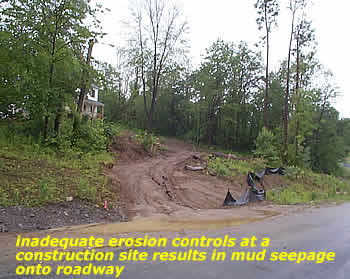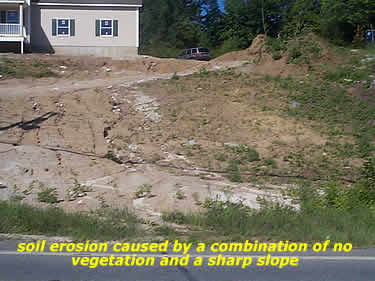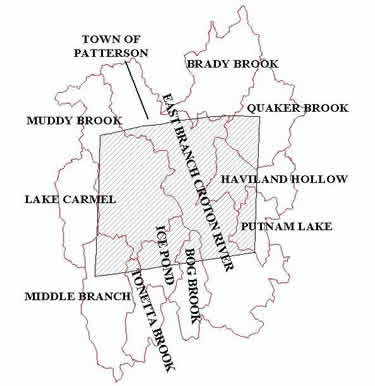
When it rains, or during periods when snow melts, only a portion of the water
will soak, or infiltrate into the ground. The portion of the water which does
not infiltrate into the ground ends up traveling overland until it reaches
a stream, or wetland or other body of water. This portion of precipitation
that travels overland is called stormwater runoff. There are two
principal areas of concern with stormwater runoff: the amount of stormwater
runoff that occurs and the quality of that runoff.

A change in the ground cover from forest to lawn, or to some type of impervious surface causes an increase in the quantity or volume of stormwater runoff. Increasing the volume of stormwater released during a storm event can increase the potential for down stream flooding, which can result in significant property damage occurring. Increasing the volume of stormwater can also cause more water to flow through a stream channel than the stream is accustomed to. This may cause important changes to the stream channel, which can be damaging to the stream and the environment.
These same changes to ground cover can also affect the quality of the stormwater runoff by increasing the concentration of pollutants in the stormwater. As storm water runoff travels over the land, it picks up and carries many natural and human-made substances such as sediment, nutrients and other pollutants that may impact water quality. In fact, almost anything on the ground can become a source of contamination as stormwater washes over the ground or a parking lot, and is carried into the storm drains and discharges into the surrounding watershed. The faster the stormwater moves, the more pollutants it can carry with it. Because the sediment, nutrients and other pollutants found in stormwater runoff come from many poorly defined or indiscreet sources, this type of pollution is often referred to as nonpoint source pollution. Changes in stormwater quality can result in changes to wildlife habitat, increased flooding, a reduction in the populations of fish and other aquatic organisms, and stream bank erosion.
There are a number of characteristics of the natural landscape that help to protect the quantity and quality of stormwater. Trees intercept rainfall and slow its velocity. Trees also provide cooling of stormwater which is important to certain types of fish habitat. Undisturbed areas of the landscape are generally full of very small natural depressions that temporarily pond stormwater and allow more time for the water to infiltrate into the ground. Similarly, the spongy humus layer of leaves on the forest floor slows the velocity of stormwater and allows more water to infiltrate into the ground.
 However, as the land is altered by people, several changes occur. Trees that
had intercepted rainfall are removed, the natural depressions that had
temporarily ponded water are graded to a uniform slope, the spongy humus layer
of the forest floor that had absorbed rainfall is scraped off, and the
underlying soils are eroded or severely compacted. These changes result in an
increase in the quantity of storm water, and a decrease in its quality, which
together effect the watershed ecology. The quantity and quality of storm water
also changes as the land's surface is changed from forest to lawns to roofs,
driveways and parking lots.
However, as the land is altered by people, several changes occur. Trees that
had intercepted rainfall are removed, the natural depressions that had
temporarily ponded water are graded to a uniform slope, the spongy humus layer
of the forest floor that had absorbed rainfall is scraped off, and the
underlying soils are eroded or severely compacted. These changes result in an
increase in the quantity of storm water, and a decrease in its quality, which
together effect the watershed ecology. The quantity and quality of storm water
also changes as the land's surface is changed from forest to lawns to roofs,
driveways and parking lots.
One of the primary sources of concentrated amounts of pollutants entering our streams and lakes, and the areas of greatest concern are impervious surfaces. Impervious surfaces are areas, including roads, parking lots, driveways and rooftops, that are so dense and hard that they prevent rainfall from entering into the ground. Many different pollutants accumulate on these surfaces from the atmosphere, from vehicles, or windblown from adjacent areas. During storm events these pollutants quickly wash off, and are rapidly delivered to downstream waters.
A watershed is the land where all of the water that is under it or drains off of it goes into the same place. Everywhere you go, you are in a watershed.
The entire Town of Patterson is in the watershed for the New York City Reservoir System. This means that our streams, the roadside ditches, and even the water that runs over your lawn during and after a rain all end up in one of the reservoirs that make up the Croton Reservoir system. Most of the lakes and streams in Patterson flow to the East Branch Croton River which runs south through the heart of Patterson. Eventually this river runs through the Town of Southeast and into the Croton Reservoir.
Watersheds can be further divided into individual components or sub-watersheds.The East Branch Reservoir watershed is made up of 10 of these sub-watersheds. For example, all of the land surrounding, and draining to Putnam Lake, comprises the Putnam Lake sub-watershed.

Prevention rather than remediation
The reservoir system which supplies New York City's drinking water is rated as one of the cleanest and safest water supply systems. However, right now - today - the water supply system is being threatened. Even if no more development were to occur within the watershed, the problem would still exist. The problem is excessive nutrients which are affecting the overall health of the reservoirs. Three of the four reservoirs whose watershed extend into Patterson have been found to be water quality limited. This means that they are receiving too much phosphorous, based on a guidance value established by the NYS Department of Conservation. In order to maintain a healthy watershed and a healthy reservoir system, the amount of phosphorous entering the reservoirs must be reduced. To accomplish this will require a cooperative effort by everyone who lives, and works within the watershed. After all it is our water first - which flows through our lakes and streams. But everyone must pitch in. There are a number of practices, described here and elsewhere, that you can use to help reduce the quantity of storm water runoff, and improve the its quality.